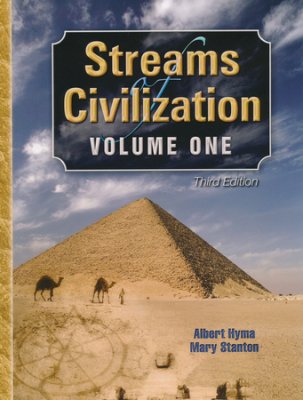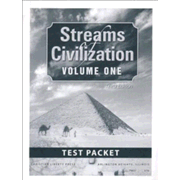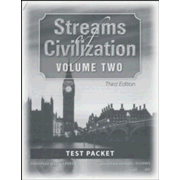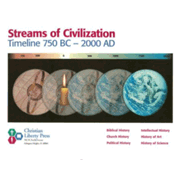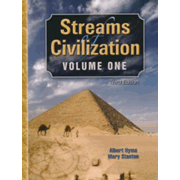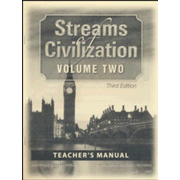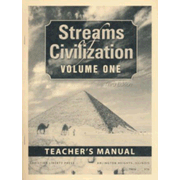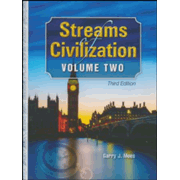Christian Liberty Press has updated and rewritten a two-volume history text through a number of printings, although much of the information in both volumes remains faithful to the original books written many years ago. This is a Christian series that emphasizes the importance of religious and philosophical views throughout history.
Both volumes were written by different authors, and Volume One is written at an easier reading level than Volume Two. Student textbooks for both volumes are sturdy, hardcover books.
The recently revised third editions of both volumes feature larger, full-color illustrations that are a significant improvement. The layout is improved as well, clearly differentiating sidebars from the main text and inserting useful subheadings. The extensive, detailed indices at the back of each book should prove helpful as well. Comprehension questions, project ideas, and a list of vocabulary words and concepts to learn are at the end of each chapter.
For each course there are a student textbook, a teacher’s manual, and a test packet. The optional Streams of Civilization Timeline is one packet of timeline charts covering both volumes. Printed on heavy-duty paper, the timelines are illustrated with key figures and events under the typical categories plus church history and intellectual history.
Volume One
authors: Albert Hyma and May Stanton
Volume One covers creation through the Reformation. Volume One can be used at either junior or senior high level, since the reading level is not that difficult. However, I expect that most homeschoolers will use it as a high school level text followed by Volume Two.
Streams of Civilization, Volume One offers more comprehensive coverage of ancient history than do many other world history texts, emphasizing a young-earth, creationist understanding of pre-history. While the text itself could be used by students in either junior or senior high, comprehension questions are certainly challenging enough for senior high level. Many questions require students to go far beyond a simple comprehension level. For example, on page 155 one question asks students to: “Compare and contrast Athenian democracy with modern American democracy.” This requires students to synthesize what they have learned about American government with what they are learning about the government of Athens in ancient Greece. Another question on the same page asks students to analyze and extrapolate from what they have learned to answer the question: “How might world history have been different had the Battle of Marathon ended in a Persian victory?”
Suggested projects at the end of each chapter often differ little from comprehension questions, although they will usually be more time consuming. Consider one suggested project on page 175: “Compare the differences between a democracy and a republic. Which form of government do we have in the United States? Which form do you feel is better? Why?” However, some project ideas offer opportunities to differentiate learning activities to suit different learning styles. On page 175, another suggestion is for students to “Draw a picture or make a model of the Roman Forum or the Senate.” Even so, most projects require research and writing and are best suited for the analytical student who likes to read and research. Projects are optional, but if parents or teachers choose to use them, they should probably select only one project for a student to complete for each chapter. Of course, if you want to make the course more challenging, you could assign additional projects.
The teacher's manual for Volume One offers complete lesson plans with overviews, objectives, teaching strategies, project ideas, vocabulary words and their definitions, answer keys, and assessment and evaluation suggestions. The new teacher’s manual is almost double the size of the previous edition. Two very significant improvements contribute to the expansion. The teacher’s manual now includes answers to the comprehension questions posed at the end of each chapter. It also repeats the list of vocabulary words found in the student text, but the teacher’s manual includes definitions for those terms and the page number in the student text where the word is either used or defined. While the vocabulary words are in bold print in the text, they are not always clearly defined. The teacher’s manual suggests having students use a dictionary or other reference tools to look up the meaning of words that are not clearly defined. Having answers to the comprehension questions as well as definitions written out in the teacher’s manual should save parents and teachers lots of time when it comes to assessing student work.
Volume Two
Original authors: Robert G. Clouse and Richard V. Pierard; revised and updated by Garry J. Moes
Volume Two covers modern history—the 16th century through about 2016, mentioning the election of Donald Trump near the end of the text. While this is a world history text, it treats many issues primarily from a "western" viewpoint.
As I already mentioned, this book is more challenging than Volume One. Church history, philosophy, and theology are integrated into historical coverage more than we find in most history texts from Christian publishers. This makes it a good choice for those who want to emphasize a biblical Christian worldview in their coursework. However, Streams of Civilization, Volume Two is written from the Reformed Protestant theological perspective as well as a conservative political position, and it offers strong opinions based upon the presuppositional ideas inherent to both.
End of chapter questions are drawn from material in each chapter. So, while they are comprehension questions to some extent, they require students to restate information and ideas in their own words. For example, these are two of the questions on page 196:
Discuss Aristotelian, inductive, and deductive reasoning. Describe the differences in these approaches to science.
Identify Kepler's laws of planetary motion.
The last few chapters that cover recent decades have been significantly updated and rewritten. Extensive discussion of Communism and the Cold War has been supplanted by recent political, military, economic, and scientific events. For example, a half-page sidebar discusses the "United States Electoral College" in light of the 2016 presidential election. In addition, there are now two chapters addressing post-World War II events in Third World countries, so the focus is not exclusively on western cultures.
The additional information along with the revised formatting enlarged the third edition to 618 pages while the second edition was only 438 pages. While it's a heftier book, it is much more visually appealing and much more readable than the second edition.
The teacher’s manual for Volume Two has only suggested answers for the end-of-chapter questions and definitions of terms. After seeing the revised teacher’s manual for Volume One, I very much wish that the teacher’s manual for Volume Two was as extensive. However, if I hadn't seen the Volume One version, I would be content with the Volume Two version as it is.




